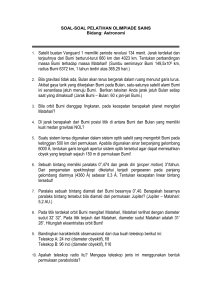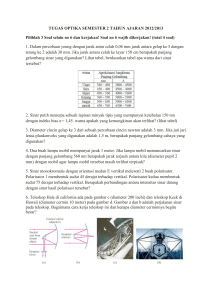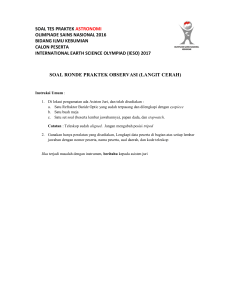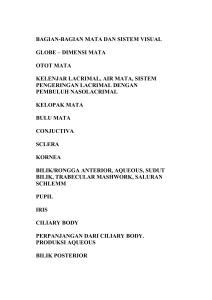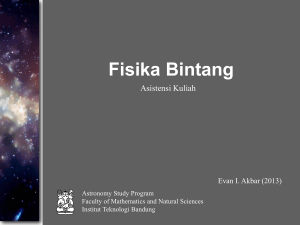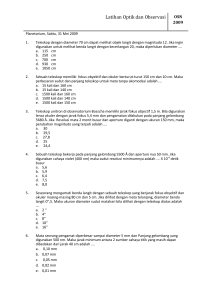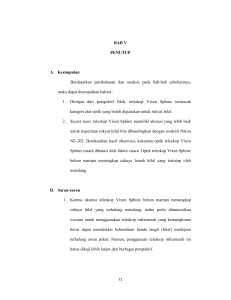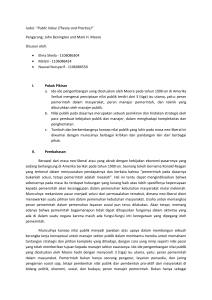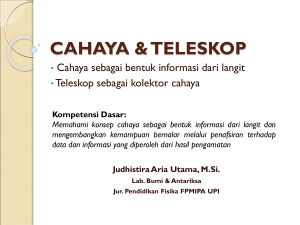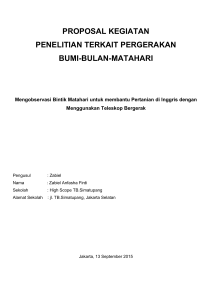Mesir Kuno - Himastron
advertisement
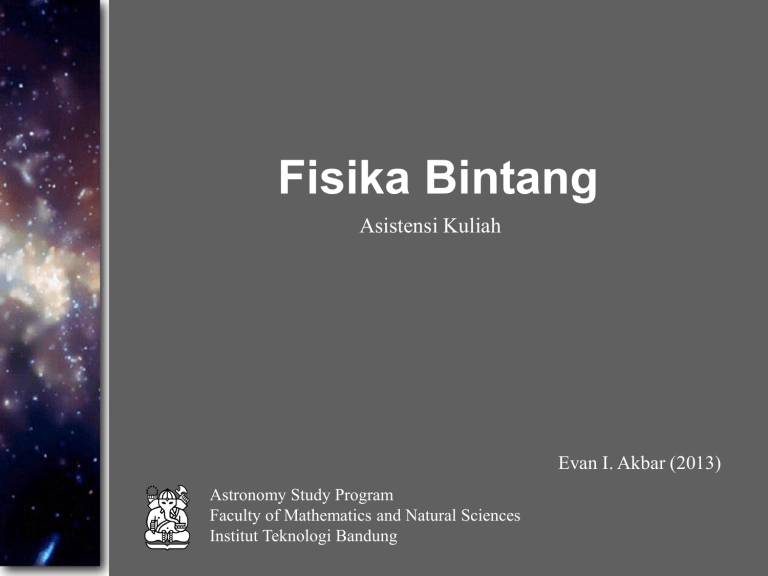
Fisika Bintang Asistensi Kuliah Evan I. Akbar (2013) Astronomy Study Program Faculty of Mathematics and Natural Sciences Institut Teknologi Bandung “The world has changed far more in the past 100 years than in any other century in history. The reason is not political or economic, but technological—technologies that flowed directly from advances in basic science.” (Stephen Hawking, “A Brief History of Relativity,” Time, 2000) Science: Observe & Take A Note Menyadari keteraturan alam castor pollux Castor Science: Wondering what, how & why? Mesir Kuno (4000 SM) Dari pengamatan bintang Sirius: 1 tahun = 360 hari Selama ribuan tahun alat yang digunakan untuk melihat luar angkasa: MATA (Lascaux : 15000 SM) (Mesir Kuno : 4000 SM) (Yunani Kuno : 400 SM) (Peradaban Islam: 1100 M) (Renaissance : 1500 M) Manusia tidak mendapat banyak informasi Sedang dalam tahap menyusun “anak tangga sains” Mata adalah kamera: • Diameter (d)= 2-7 mm • Fokus (f)= 18 mm • Punya kemampuan ‘auto focus’ & ‘fast scanning’ • Detektor: - kerucut (cones): melihat warna siang hari - batang (rods) : melihat hitam-putih malam hari • Limit difraksi= 0.8’ • Deteksi mata bersifat logaritmik Gelombang elektromagnet Relative Sensitivity Panjang gelombang optik: merah : 6 300 – 7 500 Å Sensitivity Cones merah oranye : of 6 the 000Eye's – 6 300 Å and Rods oranye : 5 900 – 6 000 Å 1.2 kuning : 5 700 – 5 900 Å 1kuning hijau : 5 500 – 5 700 Å hijau : 5 100 – 5 500 Å 0.8hijau biru : 4 800 – 5 100 Å biru : 4 500 – 4 800 Å 0.6 biru ungu : 4 200 – 4 500 Å 0.4ungu : 3 800 – 4 200 Å rods cones 0.2 Wavelength [nm] 68 0 66 0 64 0 62 0 60 0 58 0 56 0 54 0 52 0 50 0 48 0 46 0 44 0 42 0 40 0 0 ‘LOOKER’ (1600) TELESKOP (1609) Kenapa mesti membuat 10 cm (Unitron) 2 m (HST)teleskop? - Teleskop adalah mata kita - Makin besar (diameter) teleskop: • makin banyak cahaya bisa dikumpulkan • makin tinggi resolusinya 45 cm (GOTO) Sketsa bulan (Galileo, 1610) NOAO, 2002 The Leviathan Telescope (William Parsons, 1840) Hubble Space Telescope (2002) So what is a star? Alpha Cen (GOTO 45 cm) Pertanyaan itu tak mudah dijawab... Butuh dukungan ilmu fisika, matematika, kimia, atmospheric science, komputasi.... Perlu melihat yang sebelumnya tak terlihat... VLA (36 km, @ 25 m) Super Kamiokande Neutrino detector Perlu melihat yang sebelumnya tak terlihat... ... agar bisa melihat yang memang tak akan pernah terlihat VLA (36 km, @ 25 m) Super Kamiokande Neutrino detector Tujuan (asistensi) kuliah: Membantu dalam memahami: 1. Apakah bintang itu? 2. Apa yang membuat bintang bersinar? 3. Apa yang terjadi di dalam bintang? 4. 5. 6. 7. Bagaimana struktur/lapisan-lapisan di dalam bintang? Apakah bintang berubah? Berevolusi? Bagaimana mekanismenya? Bagaimana astronom bisa tahu itu semua? Bagaimana membaca simbol dan rumus? Exercises Membaca Berimajinasi Mengerjakan soal di kelas PR? Praktikum: o Memodelkan struktur dalam bintang Referensi [1] Dina Prialnik, 2000 An Introduction to the Theory of Stellar Structure and Evolution [2] Winardi Sutantyo, 1984 Astrofisika: Mengenal Bintang [3] Evry L. Schatzman & Francoise Praderie, 1990 The Stars [4] Lawrence H. Aller, 1991 Atoms, Stars and Nebulae a. b. c. d. e. f. g. h. Schaum’s Outlines: Astronomy Fundamental Astronomy 5th edition Patrick Moore’s Practical Astronomy Series: Astrophysics is easy! Patrick Moore’s Practical Astronomy Series: Starlight Patrick Moore’s Practical Astronomy Series: The Rainbow Sky Physics of Star Formation in Galaxies Britannica Illustrated Science Library Online Lecture notes
